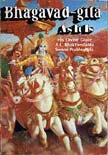 Question: I have noticed that many of your Krsna Talk articles have a somewhat controversial spin and even a fighting spirit. Do you think this is actually necessary?
Question: I have noticed that many of your Krsna Talk articles have a somewhat controversial spin and even a fighting spirit. Do you think this is actually necessary?
Answer: Yes, preaching means fighting – fighting with illusion and misconception. Our weapons are philosophical arguments backed by sastra and the opinions of previous acaryas. Preaching means speaking the truth and the nature of truth is that it wants to be found and it wants to fight with ignorance and misconception.
The Mayavadi thinks that when one has realized the truth, no need of expression is necessary — that one should simply remain silent. But a Vaisnava is different — the more a Vaisnava realizes about the Absolute Truth, the more it is important to speak the truth and to challenge misconception. Bhaktisiddhanta Sarasvati Thakura has put it this way –
“The effective silencing of the whole race of pseudo-teachers of religion is the first clear indication of the appearance of the Absolute on the mundane plane. The bona-fide teacher of the Absolute, heralds the Advent of Krsna by his uncompromising campaign against the pseudo-teachers of religion.” [Excerpted from the essay ‘Putana’ printed in the January 1932 edition of The Harmonist, or Sri Sajjana-tosani.]
An ‘uncompromising campaign against the pseudo-teachers of religion’ means to aggressively fight against misconception. Controversy not only sells, but it strengthens ones conviction also.
siddhanta baliya citte na kara alasa
iha haite krsne lage sudrdha manasa
"One should not neglect to discuss such conclusions, thinking them to be controversial, since such discussions strengthen the mind. In this way one’s mind becomes attached to Krsna." (Caitanya-caritamrta, Adi 2.117)
The truth wants to be found and when it is found it wants to be spread. Like light that comes forth with incredible speed and force to destroy darkness — the truth penetrates the realm of maya and destroys the ignorance that binds the conditioned souls.
After all, one should remember that Bhagavad-gita was spoken on the battlefield of Kuruksetra and not in a bower in Vrndavana. Other gitas are spoken by Krsna in Vrndavana, but only after having destroyed the demons who threatened the peace and well-being of the Vrajavasis.
Unwillingness to confront philosophical controversy stems from a weakness of heart, a lack of faith, a lack of surrender and a lack of attachment to the Supreme Lord. If we love someone and that person is being vilified or misrepresented then our love will command us to defend that person or to oppose their enemies.
We are sometimes unwilling to engage in philosophical controversies, thinking that such a mood is due to anarthas in our own heart or a manifestation of enmity toward other living entities. However, this may be due to apathy rather than humility.
tasmad ajnana-sambhutam hrt-stham jnanasinatmana
chittvainam samsayam yogam atisthottistha bharata
“Therefore the doubts which have arisen in your heart out of ignorance should be slashed by the weapon of knowledge. Armed with yoga, O Bharata, stand and fight.” [Bhagavad-gita 4:41]
 Here is a summary of the engaging spirit of Srila Bhaktisiddhanta and his Gaudiya Matha mission, given by Srila Sridhara Maharaja:
Here is a summary of the engaging spirit of Srila Bhaktisiddhanta and his Gaudiya Matha mission, given by Srila Sridhara Maharaja:“Our Guru Maharaja was different. Like Mahaprabhu and Nityananda Prabhu, he wanted to attack maya and, like a great general, he declared totalitarian war on illusion and even all other existing conceptions of religion. ‘Why is there this misunderstanding and misconception?’ he thought. Everything belongs to Krsna: isavasyam idam sarvam. It is plain and simple and sweet. How can we think, ‘This is for me, that is for Him?’ Why should we let this misconception stand here at all? Attack it and crush the whole thing!
“He told us, "Kirtana means to preach against misconception. As soldiers, you must go door to door and preach Krsna consciousness – Krsna's interest – the Krsna conception. If they understand that everything is for Krsna, they will be saved. This truth is plain and simple. Why should they not understand this? Try to capture them, to release them from the world of misconception and misunderstanding where they are now suffering from reaction.” [The Golden Volcano of Divine Love, Chapter 3]
 “No recognition of the jati-brahmanas, jati-gosvamis, these babajis, the Ramakrishna Mission — all foes, no friend! This is Gaudiya Matha. Single-handed they are fighting with everyone existing in the name of religion or non-religion or hodge-podge religion. Single-handed. Our Guru Maharaja, on the basis of Bhaktivinoda Thakura’s findings, took the sword and declared war against the whole world. That was his characteristic.” [Encounters With Divinity, page 26-27]
“No recognition of the jati-brahmanas, jati-gosvamis, these babajis, the Ramakrishna Mission — all foes, no friend! This is Gaudiya Matha. Single-handed they are fighting with everyone existing in the name of religion or non-religion or hodge-podge religion. Single-handed. Our Guru Maharaja, on the basis of Bhaktivinoda Thakura’s findings, took the sword and declared war against the whole world. That was his characteristic.” [Encounters With Divinity, page 26-27]
It is easier to recognize the enemy when the enemy says there is no God, God is dead, life comes from matter and so forth, but it becomes more difficult to recognize the enemy when he comes dressed in the guise of a religious mentor [as is the case with the Yavana and Mleccha preachers].
Such so-called religious mentors are sometimes in the dress of the preacher of a foreign religion and sometimes in the dress of a Vaisnava. At this time it is certainly more difficult to identify falsity and therefore only the grace of one’s guru and a prudent understanding of Gaudiya siddhanta will enable us to understand who is who and what is what.
It is not that we should only engage in philosophical controversy with Christians, atheists and Mayavadis. Anywhere we find the teachings of Mahaprabhu and our acaryas being minimized or misrepresented, then we must oppose that. It is the duty of a disciple to struggle to uphold the dignity and teachings of his guru and previous acaryas.
This duty falls particularly to the sannyasis who are called, ‘Maharaja.’ Maharaja means ‘great king’ and a sannyasi is called such not because he accumulates great wealth and rules a kingdom [as is the case with many charlatans], but because his duty is to fight against misconception and give support and shelter to the Vaisnava community.
Every Gaudiya Vaisnava sannyasi receives a tridanda [staff] at the time of initiation and at the top of that tridanda is a ‘K’ shaped symbol called the parasu-mudra meaning the axe. This is not just any axe, but it is a battle-axe to cut the head of illusion and ignorance. Sridhara Maharaja once said, “It is the emblem of cutting the anarthas of those we preach to, as well as those of the disciple.” [Encounters With Divinity, page 180]
If you are interested in joining the fight against maya and engaging yourself wholeheartedly in the service of your Gurudeva without duplicity or weakness of heart. then you should be interested in taking sannyasa or assisting a sannyasi in his preaching work. As an anonymous monk once said, “Take sannyasa or assist the preaching, but whatever you do, don’t give up the fight!”




